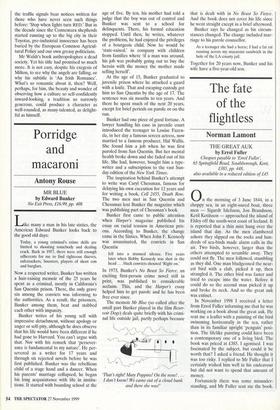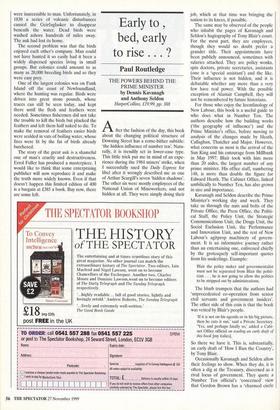The fate of the flightless
Norman Lamont
THE GREAT AUK by Errol Fuller Cheques payable to 'Errol Fuller', 65 Springfield Road, Southborough, Kent, £385, pp. 448, also available in a reduced edition of £45
n the morning of 3 June 1844, in a choppy sea, in an eight-oared boat, three men — Sigurdr Islefsson, Jon Brandsson, Ketil Ketilsson — approached the island of Eldey off the south-west coast of Iceland. It is reported that a thin mist hung over the island that day. As the men clambered ashore they slipped on the rocks and hun- dreds of sea-birds made alarm calls in the air. Two birds, however, larger than the others attempted to scramble away. They could not fly. The men followed, stumbling as they did. One man bludgeoned the near- est bird with a club, picked it up, then strangled it. The other bird was faster and tried to escape into the water. Before it could do so the second man picked it up and broke its neck. And so the great auk was extinct.
In November 1998 I received a letter from Errol Fuller informing me that he was working on a book about the great auk. He sent me a leaflet with a painting of the bird swimming horizontally in the sea, rather than in its familiar upright 'penguin' posi- tion. The lifelike painting could have been a contemporary one of a living bird. The book was priced at /385. I agonised. I was fascinated by the subject, but could it be worth that? I asked a friend. He thought it was too risky. I replied to Mr Fuller that I certainly wished him well in his endeavour but did not want to spend that amount of money.
Fortunately there was some misunder- standing, and Mr Fuller sent me the book. Once I had received it I was enthralled. This brilliantly and lavishly illustrated work of scholarship is a treasure trove of pic- tures and information about this vanished, mysterious bird: maps, plates of different coloured eggs, photographs of all the stuffed great auks in museums around the world and descriptions of the remote islands where the bird could once be found. One such island was St Kilda, where one ol the last auks was killed, suspected of being a witch and causing a storm.
I have always been fascinated by the great auk. As a child I had an ambitious hope that I would one day discover that it was not extinct. There were always rumours that perhaps other birds had sur- vived after 1844. There is no doubt that it had existed in Shetland where I spent my childhood. I dreamt that one day, clamber- ing over the cliffs of Noss or Unst, I would spy on the waves of the North Sea the one last living great auk. It was not to be, although the dream remained with me for a long time. I sometimes have it even today.
The great auk has always exercised men's imaginations, and not just after it became extinct. Perhaps it has something to do with its strange-sounding name. Its other name, `garefowl', like dodo, today evokes a bygone age. Three hundred years ago it was a familiar sight for a few months of the year to the fishermen who lived on reefs and skerries. The birds fed on fish and crabs, came in May, climbed ashore, laid their eggs without a nest, then vanished. In winter they were far out at sea and seldom seen.
The great auk was unable to perform the one function that characterises a bird, and yet it could 'fly' through the water with great ease. It had a superficial resemblance to the penguin and was about 30 inches tall, black and white, with a huge beak and absurdly small wings. But it was not a pen- guin and belonged to the family of auks, or Alcidae, of 20 species, including puffins, razorbills and guillemots. Most are squat sea-birds, and all but the great auk fly fast. They are more closely related to gulls or waders than penguins.
Some naturalists have tried to deny man's responsibility for its demise and argued that it was always doomed. But mankind cannot be acquitted that easily. Significantly, the penguin which is also flightless, has survived and prospered in Antarctica. Of course penguins too were butchered, but not with the same intensity. As Mr Fuller shows beyond doubt, man hunted the great auk out of existence. It was pursued for its feathers, oil and meat, to be eaten or used as bait.
Fate did not help the great auk. One of its last strongholds were the Geirfuglasker, a group of volcanic islets off the south- west coast of Iceland which had two attrac- tions. Firstly, as the islands lay low in the water it was easy for the unwieldy, flightless birds to jump on and off. Secondly, they were inaccessible to man. Unfortunately, in 1830 a series of volcanic disturbances caused the Geirfuglasker to disappear beneath the water. Dead birds were washed ashore hundreds of miles away. The auk had lost its home.
The second problem was that the birds enjoyed each other's company. Man could not have hunted it so easily had it been a widely dispersed species living in small groups. But colonies could amount to as many as 20,000 breeding birds and so they were easy prey.
One of the largest colonies was on Funk Island off the coast of Newfoundland, where the hunting was regular. Birds were driven into great stone pounds, whose traces can still be seen today, and kept there until the flesh and feathers were needed. Sometimes fishermen did not take the trouble to kill the birds but plucked the feathers and left them half naked to die. To make the removal of feathers easier birds were scalded in vats of boiling water, whose fires were lit by the fat of birds already butchered.
The story of the great auk is a shameful one of man's cruelty and destructiveness. Errol Fuller has produced a masterpiece. I would like to think that some enterprising publisher will now reproduce it and make the truth more widely known. Even if that doesn't happen this limited edition of 400 is a bargain at £385 a book. Buy now, there are some left.




























































































 Previous page
Previous page